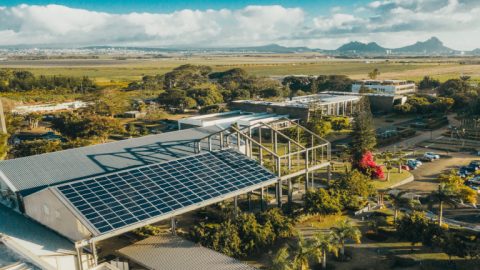In this article, we will explore the science behind these remarkable devices and their pivotal role in generating electricity. Solar panels are not mere rooftop adornments; they are the superheroes of renewable energy.
Photovoltaic Conversion
Understanding the Photovoltaic Effect
Let’s explore the photovoltaic effect, which is the secret behind solar power panels‘ charm. This may appear complicated, yet it is simply easy. Solar panels, like charmed wands, use the photovoltaic effect to convert sunlight into power. When sunlight strikes the solar cells, electrons are stimulated, causing them to travel and generate an electric current. It’s as enchanting as it sounds!
The Alchemy of Solar Cells
Imagine tiny cells within a solar panel, made primarily of silicon. When sunlight graces these cells, it works its alchemical wonders, energizing the electrons within the silicon. This prompts a merry dance of electrons, resulting in the creation of an electric current
These solar cells are made of a p-n junction, which is formed by joining two different types of semiconductors, a p-type and an n-type. When these two types of semiconductors are combined, an electric field is created in the junction region as electrons migrate to the positive p-side and holes move to the negative n-side. This field enables negatively charged particles to flow one way and positively charged particles to move the other. It is this process which creates a current in the cell. . This current is then captured and dispatched to power your home. It’s akin to bottling sunshine, but in this case, its electricity flowing through your wires!
Components of a Solar Panel
A. Layers and Materials in Solar Panels
Solar panels may appear deceptively simple, but they are intricate machines. They consist of various layers, including a protective glass cover, solar cells, and a supportive backsheet. These layers operate in harmony to ensure optimal panel performance.
B. The Orchestra of Components
The glass cover serves as a guardian, shielding the solar cells from the elements while permitting sunlight to work its magic. The solar cells are the stars of this performance, converting sunlight into electricity. The backsheet plays the role of a steadfast supporter, ensuring the panel remains stable. Each component plays a distinct role in this symphony of solar power.
Installation and System Integration
A. Factors to Ponder When Installing Solar Panels
Installing solar panels is more than just placing them on your roof; it requires thoughtful consideration. Factors such as panel angle, orientation, local climate, and shading must be taken into account. A well-planned installation ensures that your panels function efficiently and maximize electricity production.
B. The Connection to Your Electrical System
After your panels are installed, you must integrate them into your electrical system. This is accomplished with the use of an inverter, a magical mechanism that converts the direct current (DC) supplied by the solar panels into the AC, or alternating current, utilized in your home. It’s the wizard behind the scenes that makes your solar energy usable.
Electricity Generation and Utilization
A. Solar Electricity Generation
As long as the sun graces the sky, your solar panels are diligently generating electricity. They can even produce surplus electricity, which can be fed back into the grid or stored for later use. This means you can enjoy power even when the sun takes a siesta.
B. Creative Applications of Solar Electricity
The electricity produced by your solar panels can power your home, reducing your reliance on conventional energy sources. Additionally, you can benefit from net metering, earning credits for any excess electricity sent back to the grid. It’s like receiving a bonus for embracing green energy!
Advantages of Solar Panels
A. Environmental Blessings
Solar panels are champions of the environment. They help to reduce greenhouse gas emissions, air pollution, and our reliance on fossil fuels. By using solar energy, you are not just lowering your carbon footprint; you are also assisting in the creation of a cleaner, healthier environment for future generations.
B. Financial Gains and Incentives
Besides their environmental merits, solar panels can also be a boon for your finances. They can significantly reduce your electricity expenses while also providing tax breaks and refunds. It’s a win-win situation for both you and the environment.
Finally, solar panels are more than just sparkling roof additions; they are essential for harnessing the sun’s energy for clean, sustainable electricity generation. Understanding how photovoltaic cells function and the myriad benefits they give can help you join the renewable energy movement and have a good impact on the world.


































